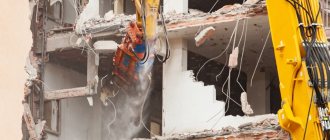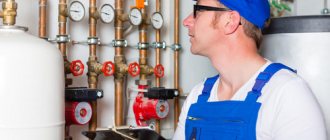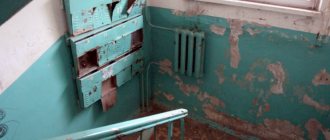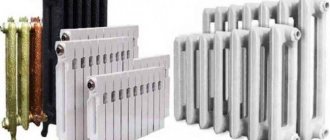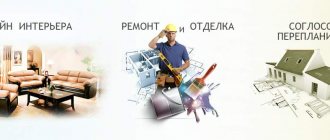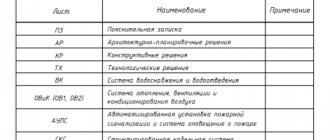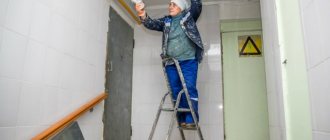What is the maintenance and repair of heating systems? Who can and should do these jobs? What do repair instructions look like, for example, for valves in an elevator unit? Let's try to answer these questions.
Let's start with a small disclaimer.
This article presents purely the practical experience of a former plumber with many years of experience. It is possible that constantly changing legislation and standards now require that repair work be carried out differently; however, this is exactly what happens in the real world.
So let's get started.
We will try to find out who solves problems of this kind and how.
Carrying out work to ensure heat supply in apartment buildings
The main regulations that should be relied upon when resolving issues related to the restoration of the heating system:
- Decree of the State Construction Committee of the Russian Federation No. 170 “On approval of the Rules and Standards for the Technical Operation of the Housing Stock” (hereinafter referred to as PG of the Russian Federation No. 170) defines the types of repair work, the rules and regulations for their implementation, the list of works and who carries out them.
- Decree of the Government of the Russian Federation No. 491 (hereinafter referred to as RF PP No. 491) defines the “common property” of MKD. Details the elements to be repaired depending on the degree of wear. Regulates organizational issues.
- The Housing Code (hereinafter referred to as the Housing Code of the Russian Federation) explains the sources of financing for repairs and the features of contractual relations.
In accordance with clause 1.8 of the RF PG N 170, the following types of repairs can be carried out to maintain engineering systems in proper condition:
Let’s determine what their difference is, and what conditions create the prerequisites for each type of repair.
Capital works
Major repairs are a set of measures aimed at eliminating breakdowns of worn-out structural elements of the heating supply of apartment buildings, which are part of the common property. At the same time, work is being carried out to replace or restore them in order to bring them to current operational standards (Article 2 of Federal Law No. 185-FZ).
Prerequisites for carrying out a major overhaul of the heating system:
- development of the service life established by the standards (service life of steel heat supply communications - 25 years);
- a situation arises when individual space heating elements that are in common ownership violate the established maximum permissible reliability characteristics and create a safety hazard (clause 21 of RF PP No. 491).
What is included in the work to restore heat supply during a major overhaul (clause 7.2 STO NOSTROY 2.33.120-2013):
- Complete or partial replacement of intra-house heat supply lines, including risers, branches from risers into the apartment.
- Replacement of control and shut-off valves, including on the branches of risers to heating devices in apartments.
- Replacement of radiators in common areas (entrances, basements).
- Selective replacement of heating radiators in residents' apartments - in the absence of shut-off devices.
The last point of the above list is the most controversial. The fact is that heating radiators, in accordance with clause 6 of RF PP No. 491, are classified as common property, that is, those that serve more than one premises (Article 36 of the RF Housing Code). This means that residents who carry out repairs can theoretically qualify for a free replacement.
In practice, the owner of an apartment during restoration work can try to replace his heating device free of charge only if there are no disconnecting devices on the apartment riser, which will allow the radiator to be recognized as part of the general heating system.
Issues of organizing and carrying out major repairs of the heat supply system in the apartment building are entrusted to the management company. The work can be carried out either by a contractor or with the help of the company’s own personnel with the conclusion of a contract. The latter is more beneficial for residents, as it provides more guarantees against possible quality claims.
Current replacement of elements
It is carried out in a planned manner in order to prevent wear and tear of structural elements related to common property (clause 18 of RF PP No. 491).
The frequency of routine repairs for the heat supply system is not established by law. Repairs are carried out once every few years when deficiencies are identified during scheduled or seasonal inspections and require elimination.
Frequency of central heating inspections:
- scheduled - once a year (Appendix 1 of the RF PG N 170);
- seasonal - 2 times a year: in spring and autumn (clause 13.1 of RF Regulation No. 491).
Legal implementation of this type of repair is possible in two ways:
- The decision on repairs is made by the general meeting of residents on the basis of an inspection report if the residents of the apartment building wish to independently organize the work (clause 14, clause 18 of RF PP No. 491). The contractor is selected by the homeowners.
- Heating restoration work is carried out automatically, without the participation of residents. The contractor is the service organization to which the responsibilities for monitoring the heating network in the house are delegated.
The list of works during routine repairs includes the following measures for the restoration and replacement of individual elements of central heating (clause 11 of appendix 7 of the Russian Federation State Regulation No. 170 and clause 11 of appendix 2 of MDK 2-04.2004):
- Restoration or replacement of individual sections of risers, pipelines, shut-off and control mechanisms.
- Hydraulic testing of the heating system.
- Restoring the integrity of thermal insulation.
- Replacement of individual pumps or electric motors.
- Replacement of individual sections of heating devices.
- Partial replacement of sections of cast iron boilers, fittings, chimneys in the boiler room (if any).
Responsibilities for carrying out routine heating repairs “by default” are assigned to the management organization with which the owners of the apartment buildings have entered into a corresponding agreement (clause 16 of RF PP No. 491).
Troubleshooting
Emergency work on the heat supply system of an apartment building is carried out with the aim of urgently restoring the functionality of the heating system in the event of an accident. In accordance with paragraph 3 of Appendix 1 of MDK 2-04.2004, emergency maintenance of central heating includes the following activities:
- eliminating leaks in pipes, risers, heating radiators by sealing connections;
- repair or replacement of emergency shut-off valves;
- repair of emergency sections of the pipeline by repairing or replacing pipes;
- replacement of emergency pipeline sections up to 2 m long;
- welding work to the extent necessary to eliminate the malfunction.
Read more: Early pension for the mother of a disabled child since childhood
Emergency faults of pipelines and connections in heat supply systems must be eliminated immediately (Appendix 2 of the RF PG No. 170).
Emergency heating work is included in the housing maintenance fee (Appendix 1 MDK 2-04.2004).
Who performs emergency work:
- during working hours, troubleshooting should be done by plumbers of management companies or housing offices servicing apartment buildings;
- during non-working hours, weekends and holidays - emergency repair services of organizations involved in servicing the housing stock (clause 7.7 of the RF PG No. 170).
Who is to blame for the system malfunction?
All accidents associated with the heating system can be divided into intra-apartment and intra-house. This separation allows you to determine who is to blame for the problems.
Legally, responsibility for the heating system rests with consumers of services and the companies that provide them. The management company is fully responsible for the in-house system, so the blame for the accident falls on this organization.
Limits of responsibility between owners and management companies
Owners of housing in apartment buildings must ensure the safety of not only their apartment, but also common property. By signing the contract, each tenant agrees to these conditions of living in the apartment building.
And yet, many people believe that since the batteries are in their apartment, they belong to them by right of ownership. However, the heating system along with the radiators is included in the structure of the common property of the house. Therefore, only management companies are involved in their repair and replacement.
Cost of replacement as part of a major overhaul
The legislation of the Russian Federation places the burden of payment for major repairs of apartment buildings (including replacement of heating) on apartment owners.
Is this included in the payments for major repairs?
Since 2014, residents must transfer funds monthly to a special fund, from which capital repairs are subsequently paid (Article 169 of the Housing Code of the Russian Federation). The amount of contributions for each owner is calculated individually by multiplying the tariff established in the region by the total area of the apartment. The law does not provide for a separate fee for major heating repairs.
Both current and major heating repairs are similar in that they are carried out as planned, but differ in scale and goals. Central heating elements that are in common ownership of the apartment building residents are subject to restoration work. The ultimate goal of the repair is the safe operation of the heating system.
If you find an error, please select a piece of text and press Ctrl+Enter.
A major overhaul of the heating system in an apartment building becomes relevant when there are frequent complaints from residents about the unsatisfactory quality of the services provided, in case of various leaks, or due to the old age of the equipment. Depending on the expected problems, various types of work are performed, the main task of which is to maintain the heating unit in proper condition.
Flushing the heating system in an apartment building
Household heat meters
establishes the obligation to equip apartment buildings with common house meters for water, electricity, heat and gas. They are usually installed in technical rooms (basements, utility rooms).
Using counters, you can record the amount of resources spent. At the same time, not only individual meters are installed for thermal energy, but also multi-tariff ones, which allows you to pay cheaper at night rates.
The management company is responsible for the maintenance of common house appliances. It monitors that utility bills correspond to the amount of resources consumed.
Find out how to install a communal heat meter in an apartment building.
Types of repair work of heating systems
Types of heating repairs in an apartment building can be divided into the following categories:
- Maintenance. The main part of the search for problems for this type of work is carried out during routine inspections of equipment in preparation for the heating season. During the period of special audits, minor defects in the system are identified, which are corrected taking into account the technical characteristics of the heating unit;
- major heating repairs are carried out after a certain period of operation of the building and include the dismantling and installation of new components instead of failed units. Here pipes, radiators, valves and other elements of the system can be changed;
- emergency repair. It is carried out urgently and includes work to eliminate emergency situations. This may include measures to eliminate various leaks that may appear as a result of ruptures in riser pipes, elevator plugs, or freezing of a piece of the system.
Preparatory work for the heating season is carried out during the shutdown of the system during the summer break in equipment operation. Water is drained from the structure, which makes it possible to carry out repairs without harm to the residents of the house.
Heating system of an apartment building
Service organizations
In apartment buildings, the responsibility for maintaining the heating system falls on the shoulders of the management company. The latter has the right:
- carry out all work by its employees;
- attract contractors.
Concluding a contract for system maintenance
To carry out maintenance work on the heating system, a special contract must be concluded. This document contains the following information:
- list of services provided, their individual components and characteristics;
- turnaround time;
- cost of services;
- rights and obligations of the parties;
- liability for violation of the provisions of the agreement.
The agreement can be concluded once or re-signed periodically. This document is a guarantee that the heating system will work efficiently.
Maintenance
In preparation for the heating season, specialists from housing maintenance offices must carry out inspections of heating systems annually. But due to lack of personnel and funding, such events are often simply ignored. As a result, repair work can begin only after a written request from the residents of the house to higher authorities or after receiving a complaint. In the latter case, a commission is created and the following types of heating system repairs are performed:
- checking the operation of the elevator unit of the building and then resetting all valves and gate valves. If necessary, these parts are replaced with new ones. This can also include replacing oil seals and lubrication of rods;
- during the inspection of shut-off valves, worn gaskets are replaced;
- When repairing valves, spacer wedges are restored by grinding in the mirrors, replacing the pressure rings and restoring the rods. Purchasing new valves is not rational, they are very expensive, so this part will be repaired until the last minute.
A cast iron valve by its appearance will never indicate the need for repair, therefore, during routine repairs, the following types of work of a similar plan are carried out:
- checking the locking mechanisms of risers. If these elements are not working properly, then at the slightest damage or leak, it will be necessary to reset the entire house, and this is dangerous during winter frosts and can result in freezing of the system in many areas of the entrance;
- After certain periods of time, it is also necessary to check the fastening of the locknuts. This measure is necessary due to the fading of technical flax, and houses in which sealing was carried out with materials that are not afraid of fading were built in the last century.
But the main work of the team for routine heating repairs in an apartment building is to fully service the system, start it up and eliminate air jams during heating start-up, if residents from the upper apartments cannot do this on their own.
But to avoid bureaucratic delays, contracts are usually concluded between a home maintenance organization and its own repair teams. Workers carry out repairs during personal weekends or vacations. At the same time, the contractors themselves are interested in high-quality performance of the work, because in the event of unsatisfactory repairs, the consequences will have to be eliminated by them. During a major overhaul, the following types of work are performed:
- complete or partial replacement of heating lines or risers;
- complete or selective replacement of heating devices;
- replacement or installation of a new locking part of the elevator unit;
- complete or partial replacement of heating spills.
DIY battery repair
Most often, emergencies occur with batteries and heating radiators. This is due to the peculiarities of their operation. Timely repair of heating radiators will not only help eliminate the accident, but will also make it possible to use this heating element in the future.
There are a number of reasons why a radiator fails. The main one is the rusting process - the reduction of pipe walls. They cannot withstand the pressure of the system, and a gap forms. To quickly resolve the problem, you can perform a temporary repair of the heating radiator yourself. It is best to use cold welding for this. You must first check whether it is designed for use with the radiator material.
Below is the procedure for self-repairing heating batteries:
- Disconnect the radiator from the general heating system.
- Determine the location of depressurization and clean it of dirt, paint and grease.
- Prepare hot welding solution. If it is two-component, you should act strictly according to the instructions from the manufacturer.
- Repairing a heating radiator with your own hands - apply cold welding to the fabric base and wrap the leak area.
- For better sealing, it is recommended to secure the patch with a mounting clamp. If this is not possible due to the design of the battery, we apply an additional layer of cold welding.
After repairing the heating battery, you can reconnect it to the general heating system. But this should be done only after the cold weld has completely dried.
Carrying out such a repair of a heating radiator with your own hands will only temporarily solve the problem. The best option for restoring the functionality of the radiator is to replace the section or use electric (argon) welding.
After completing the restoration work, remove the air plugs from the radiator by opening the Mayevsky valve.
Emergency repair
The name alone makes it clear that emergency work is carried out in situations where urgent assistance is required. Among the most common problems of this kind are:
- no riser heating. First, the locking mechanisms and valves are inspected; sometimes uncoordinated actions between residents and utility services lead to them simply being closed;
- There is no full water supply to the system. The cause may be an extra object getting into one of the pipes. It could be a piece of rust or slag stuck on a bend in the pipeline. After its elimination, the air is vented from the upper floors, and the system is put into operation;
- leak detection. If there is no threat of destruction, then the brigade’s responsibilities include the task of applying a fastening bandage to eliminate the leak. Next, welding work will be carried out by maintenance specialists.
When the system freezes, the entire riser is turned off and the location of the problem is carefully calculated; after it is detected, the pipe is heated to remove the cause of the malfunction.
Read more: How to add to the agreement that it is possible to use the UPD
Types of repair work of heating systems
Types of heating repairs in an apartment building can be divided into the following categories:
- Maintenance. The main part of the search for problems for this type of work is carried out during routine inspections of equipment in preparation for the heating season. During the period of special audits, minor defects in the system are identified, which are corrected taking into account the technical characteristics of the heating unit;
- major heating repairs are carried out after a certain period of operation of the building and include the dismantling and installation of new components instead of failed units. Here pipes, radiators, valves and other elements of the system can be changed;
- emergency repair. It is carried out urgently and includes work to eliminate emergency situations. This may include measures to eliminate various leaks that may appear as a result of ruptures in riser pipes, elevator plugs, or freezing of a piece of the system.
Preparatory work for the heating season is carried out during the shutdown of the system during the summer break in equipment operation. Water is drained from the structure, which makes it possible to carry out repairs without harm to the residents of the house.
Heating system of an apartment building
What is washer system
It often happens that in a house located next to a boiler room, the radiators become so hot that residents are forced to open windows, and residents of distant buildings freeze. To avoid this, technicians take measures to distribute heat evenly between consumers.
Washing the heating system of an apartment building is the process of installing special washers with holes of the required caliber on the branches of heating networks. Thanks to this, nearby buildings receive less heat, part of which is sent to distant apartment buildings.
Using such a system allows you to reduce:
- carrier flow through pipes;
- number of boilers used;
- consumption of electricity and fuel.
At the same time, the costs of this procedure are low.
Maintenance
In preparation for the heating season, specialists from housing maintenance offices must carry out inspections of heating systems annually. But due to lack of personnel and funding, such events are often simply ignored. As a result, repair work can begin only after a written request from the residents of the house to higher authorities or after receiving a complaint. In the latter case, a commission is created and the following types of heating system repairs are performed:
- checking the operation of the elevator unit of the building and then resetting all valves and gate valves. If necessary, these parts are replaced with new ones. This can also include replacing oil seals and lubrication of rods;
- during the inspection of shut-off valves, worn gaskets are replaced;
- When repairing valves, spacer wedges are restored by grinding in the mirrors, replacing the pressure rings and restoring the rods. Purchasing new valves is not rational, they are very expensive, so this part will be repaired until the last minute.
A cast iron valve by its appearance will never indicate the need for repair, therefore, during routine repairs, the following types of work of a similar plan are carried out:
- checking the locking mechanisms of risers. If these elements are not working properly, then at the slightest damage or leak, it will be necessary to reset the entire house, and this is dangerous during winter frosts and can result in freezing of the system in many areas of the entrance;
- After certain periods of time, it is also necessary to check the fastening of the locknuts. This measure is necessary due to the fading of technical flax, and houses in which sealing was carried out with materials that are not afraid of fading were built in the last century.
But the main work of the team for routine heating repairs in an apartment building is to fully service the system, start it up and eliminate air jams during heating start-up, if residents from the upper apartments cannot do this on their own.
Heating repair instructions
Before painting, the old layer from the radiators is removed with chemicals or a brush.
Without interfering with the overall heating system, the apartment owner can independently carry out a number of measures to improve its operation within his property.
You should start by repairing cast iron heating radiators. These products have a large volume, which is why the circulation rate in them is weak, and this leads to the formation of sediment. Over time, it becomes denser, deposited in the ribs, and blocks the channels. It's faster to change batteries, but it's quite expensive.
Restoration of old cast iron radiators is carried out in the following sequence:
- If there are taps in front of them, place them in the closed position.
- Unscrew the connecting nut. As a rule, this cannot be done right away. High heat is used to loosen the connection.
- Remove the battery from the brackets and drain the water.
- Carry out initial mechanical cleaning from the inside. After removing the hard deposits, seal the holes with plugs and pour a 10% citric acid solution inside.
- Leave for 30-40 minutes, drain the liquid, check the result. If necessary, repeat the procedure.
- Remove old paint from the exterior surface. To do this, use a wash, a manual sandblaster or an angle grinder with a metal brush.
- If intersection gaskets are leaking, replace them.
- Paint the radiator with acrylic heat-resistant paint and wait until it dries completely.
- Hang the battery in place and connect it to the pipes.
Pipes and collectors can be cleaned with a cable and a brush.
While the radiator sits with acid and dries after painting, you can start piping. Horizontal spans are often clogged with dirt and limescale. Getting rid of deposits is easy. To do this, you need to take a cable with a brush, insert it into the pipe and start moving it until the hole in the riser is reached. To achieve a better effect and speed up cleaning, add household detergent with an abrasive to the brush. The achieved result is checked visually using a flashlight for illumination.
Quite often, due to corrosion or poor-quality welding, leaks occur in pipes and radiator housings. These phenomena cannot be ignored, since the holes will constantly increase.
In such cases, you should proceed as follows:
- Turn off the water and drain the problem area. Sometimes you have to temporarily dismantle it.
- Peel the paint around the hole down to the metal. Widen the gap using a thin drill. Check that there is no rust left. Degrease the material with acetone.
- Seal the hole. To do this, you can use mastic or a rivet with a silicone washer. If there is welding, it is better to make a metal patch.
If there is no sealant or rivet at hand, the hole is closed with a clamp, under which thick rubber is placed. This method is unaesthetic, but the clamp will do its job until the end of the heating season. After draining the water from the system, you need to carry out high-quality repairs.
Major renovation
Before carrying out major work, first of all, a contract is concluded and a statement is drawn up, which sets out guidelines for the necessary materials and costs. Noi contracts are concluded in accordance with a strict procedure:
- The first step is to announce a tender for a more advantageous offer for the supply of materials, works or equipment. All enterprises providing this type of service can take part in the tender;
- after all tender registrations have been completed, contracts are concluded with a full list of future work, costs and guarantees laid out;
- after repairs are completed, depending on the satisfaction of the parties, payment is made or, if the outcome is poor, the case is sent to court.
But to avoid bureaucratic delays, contracts are usually concluded between a home maintenance organization and its own repair teams. Workers carry out repairs during personal weekends or vacations. At the same time, the contractors themselves are interested in high-quality performance of the work, because in the event of unsatisfactory repairs, the consequences will have to be eliminated by them. During a major overhaul, the following types of work are performed:
- complete or partial replacement of heating lines or risers;
- complete or selective replacement of heating devices;
- replacement or installation of a new locking part of the elevator unit;
- complete or partial replacement of heating spills.
Overhaul
There is a certain procedure for concluding contracts for major heating repairs:
- A defective list is drawn up for the upcoming overhaul with an indicative list of work and materials;
- A tender is announced for the supply of equipment and (or) the actual repair. Any municipal or private enterprise can participate in it, in which the list of services offered during registration included “repair of the heating system (OKDP code 453).
- An agreement is concluded with the organization that wins the tender, including a full list of services provided, the procedure for calculation and control, guarantees and responsibilities of the parties and a dozen more, no doubt, very important points.
- Then several weeks or months of work may, depending on the result, end in mutual satisfaction of the parties or scandals and litigation.
However, in practice, the contract is often concluded between the service organization and its own emergency or routine repair teams, which carry out repair work during vacations and weekends. The practice can only be approved: the performer has a very strong incentive to do his job well, since he will have to solve the problems of poor quality performance.
What work can be performed as part of a major overhaul? Their list is small:
- Complete or partial replacement of risers and heating lines.
- Complete or selective replacement of heating devices.
- Replacement of the entire elevator unit or shut-off valves in it.
- Full or partial replacement of heating spills.
Of course, all work is carried out in the summer, outside the heating season.
Emergency repair
The name alone makes it clear that emergency work is carried out in situations where urgent assistance is required. Among the most common problems of this kind are:
- no riser heating. First, the locking mechanisms and valves are inspected; sometimes uncoordinated actions between residents and utility services lead to them simply being closed;
- There is no full water supply to the system. The cause may be an extra object getting into one of the pipes. It could be a piece of rust or slag stuck on a bend in the pipeline. After its elimination, the air is vented from the upper floors, and the system is put into operation;
- leak detection. If there is no threat of destruction, then the brigade’s responsibilities include the task of applying a fastening bandage to eliminate the leak. Next, welding work will be carried out by maintenance specialists.
When the system freezes, the entire riser is turned off and the location of the problem is carefully calculated; after it is detected, the pipe is heated to remove the cause of the malfunction.
What applies to major repairs of utility networks?
Thus, the engineering systems of an apartment building include:
- Overhaul of water supply and wastewater systems.
- Heating system. Most apartments have traditional radiators, which heat up when stable low temperatures arrive.
- Sewerage.
- Electricity.
- Ventilation system.
- Elevator system.
- Low-current networks, thanks to which it becomes possible to use the Internet, television, etc.
However, in order for all engineering systems to function in the correct mode, i.e. without failures, it is necessary to carry out certain work aimed at maintaining the condition of the vital systems of an apartment building.
Some of them are carried out on a regular basis and are ongoing, while some work is classified as capital. For example, a major overhaul of electrical wiring in an apartment building is being carried out. To make it clearer, let’s look at this classification in more detail.
How much does the service cost and who pays for it?
In accordance with the legislation of the Russian Federation, the cost of installing meters falls on the shoulders of the owners of a residential building. Often they are initially included as part of the fee for the maintenance and repair of residential premises or as part of mandatory payments. The expenses of each owner are proportional to his share in the common property right.
Many people are also interested in how much it costs to pressurize a heating system in an apartment building. Each company sets its own tariffs. As a rule, the area of the building is taken as a basis, on which other parameters depend:
- length of pipelines;
- number of heating devices;
- thermal performance;
- the cost of the work itself.
Find out how tariffs for maintaining common property in an apartment building are calculated.
Current and major work in an apartment building
First, let's figure out what is the current repair of engineering systems, and what is a major one? Based on this, their difference from each other will be clearer, which is very important for understanding the issue itself.
Current repairs of engineering systems are carried out as planned, the purpose of which is to restore operability, partially restore their service life, which is expressed in the replacement or repair of certain components, which are expressly stated in the relevant regulations.
Such work is aimed at preventing wear, i.e. are in some way preventative.
Current work includes foundation repairs. This list includes: sealing seams and cracks, replacing foundation and wall cladding, repairing ventilation systems, etc., walls, roofs, replacing floor waterproofing, etc.
In a word, the current work is more like a cosmetic renovation, when the appearance of the building and entrance is partially restored.
The thing is that a major overhaul of the engineering systems of an apartment building means a complete replacement of these systems, each of which has its own operational life, after which major work must be carried out. In this case, the work will be carried out in the same areas as the current ones, but with a complete replacement of the main systems...
At whose expense?
All owners of apartments in the building, i.e.
those who privatized them bear the burden of responsibility for the maintenance and repair of the entire apartment building. Relatively recently, a new column appeared in citizens’ payment documents - contributions for major repairs, which is calculated based on how many square meters there are in a particular apartment. Naturally, if the apartment is larger, then the cost of major repairs will be higher.
As for those people who did not privatize their housing, i.e. live in municipal apartments, then all their costs for major repairs lie with local governments.
The issue of major repairs of engineering systems often causes a lot of confusion among people, because they are not fully informed about what kind of work it includes.
Understanding this issue will make it possible to understand the need for such expenditure, because carrying out such work is simply necessary to ensure the safety of the residents of the house in which it is carried out. Moreover, the monthly fee for major repairs is not so large that it would not be possible to pay for it.
Frequency
As mentioned earlier, each engineering system of an apartment building has its own service life. This information is clearly displayed in the technical regulations, which read as follows:
- Central heating system - 25 years.
- Replacement of hot water supply risers during major repairs - 30 years (if the risers are not galvanized, then 15 years).
- Cold water supply risers - 30 years (if the pipes are not galvanized, then 15 years).
- Overhaul of the power supply system - 20 years.
- Sewerage - 60 years (if the pipes are ceramic or plastic) and 40 years (if the pipes are cast iron).
- Roofing - depending on the material. Accordingly, a roof made of slate lasts 30 years, one made of galvanized steel - 15 years, and one made of rolled materials - about 10 years.
The above figures are the wear and tear of the main engineering systems of the building. Accordingly, capital work must be carried out after this period, including a complete replacement of the structural components of each system.
How to request ahead of time?
According to the regulations, major repairs of a building's engineering systems, for example, major repairs of a pipeline, can be carried out ahead of schedule only if a real threat to the life and health of the residents of a particular building is proven.
To make this possible, changes need to be made to the regional program, i.e. local government bodies, management organizations or homeowners' associations must submit an application to the relevant executive authority that deals with this issue.
Naturally, the decision to carry out major repairs earlier will be made only after a series of inspections and examinations of the condition of the building.
It is worth noting that to request repair of engineering systems you need to write a statement. It is designed in a free style according to the generally accepted pattern.
When starting to write an application, you should start by drawing up a header, which states to whom the application is being sent (position, company name), followed by the surname, first name and patronymic of the manager, the applicant’s initials, address and contact telephone number).
The body of the application states the essence of the problem (for example, a major overhaul of heating networks is required), indicates when the last inspection was carried out, and adds descriptions of the condition of engineering systems. This is followed by the date and signature of the applicant.
As a rule, you have to wait 10 working days for a response from the management company, which is REU, ZhEK or REMP.
The legislative framework
Legislation on heat supply issues consists of the Constitution of the Russian Federation, as well as. The latter establishes the legal basis for relations related to the production, transmission and consumption of thermal energy.
Certain aspects are regulated by by-laws and decisions of local authorities.
Find out what the standard air temperature standards are for an apartment during the heating season.

